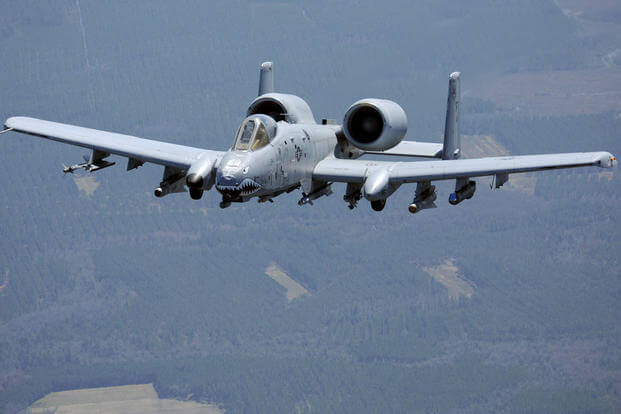The Air Force has reset the date for the earliest possible retirement of the A-10 Thunderbolt II to 2021, the service's top general said Tuesday.
"Then we're going to have a dialogue within the department of what the long-term plan is," Chief of Staff Gen. David Goldfein told reporters during a breakfast in Washington, D.C. "As a mission, we're fully committed to close-air support."
Last year, then-Defense Secretary Ashton Carter announced the aircraft's retirement would be delayed until 2022 after officials opined the Air Force was ridding the U.S. military of a "valuable and effective" close-air-support aircraft.
However, fiscal 2017 budget documents revealed the service still hoped to remove A-10 squadrons in increments between 2018 and 2022 in order to make room for F-35A Lightning II squadrons coming online.
"We're going to keep them through 2021. Then, as a result of a discussion we'll have with [Defense] Secretary Mattis and the department, and review all of our budgets -- that's when we'll determine the way ahead," Goldfein said.
The close-air-support conversation needs to swing in "a new direction" regardless of the A-10, affectionately known as the Warthog, because the mission "has changed significantly, and it will change significantly in the future if we get this right."
Goldfein cited Afghanistan as a prime example of close-air support being used heavily against the enemy, but said the A-10 isn't always the right aircraft for different climate and geographic zones.
RELATED: A-10 vs. F-35 Flyoff May Begin Next Year: General
"My job as the air component commander [at the time] when we were [involved] in a very mature ground fight in 2011 through 2013 was to ensure the ground commander's scheme of maneuver" and deliver the right kind of aircraft based on that region's topography, he said.
In the south, with its rolling, open terrain, the A-10 flourished. But basic assessment of Afghanistan's terrain determined MQ-9 Reapers were best in the east "because I needed endurance" in a mountainous terrain, Goldfein said.
In the north, Goldfein said B-1B Lancers were well-suited for the long flight time and their "significant munitions suite." The west was the specialty of the F-16 Fighting Falcon.
The "longer we have this discussion [about] the A-10 and don't connect it to how the A-10 fits into a family of systems, the more we're [stuck] having a 20th century dialogue about close-air support," he said.
The general last month announced the Air Force intends to conduct an informal experiment, dubbed OA-X, of a potential light attack fighter aircraft the service could use in ongoing counterterrorism air campaigns. Goldfein said the Air Force is looking to programs such as Textron's Scorpion to potentially provide an inexpensive fighter capable of performing close-air support missions.
The additional light attack aircraft -- which would not replace the service's beloved A-10 -- "would relieve the pressure on other aircraft, maintenance crews, [and] it would give us some turning space with our other combat platforms," said Brig. Gen. Edward Thomas, director of Air Force public affairs.
With the current budget, "I don't believe there is anything specifically programmed for it right now," Thomas said at the time, noting the experiment is in its early stages and doesn't have any funding attached.
Arizona Republican Sen. John McCain -- a big backer of the A-10 and a former Navy pilot -- suggested that while the A-10 should live on into the foreseeable future, "The Air Force should procure 300 low-cost, light-attack fighters that would require minimal work to develop," he said in a white paper released days before Goldfein's comments.
McCain said the service could procure "the first 200 of these aircraft by fiscal year 2022."
-- Oriana Pawlyk can be reached at oriana.pawlyk@military.com. Follow her on Twitter at @Oriana0214.
Related Video:
Don't Miss a Single Military.com Story
To read the full article and get exclusive benefits, sign up today.
It’s FREE
Why am I seeing this? Visit our FAQs


























